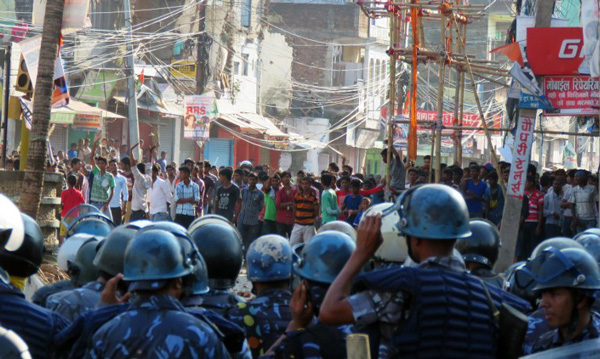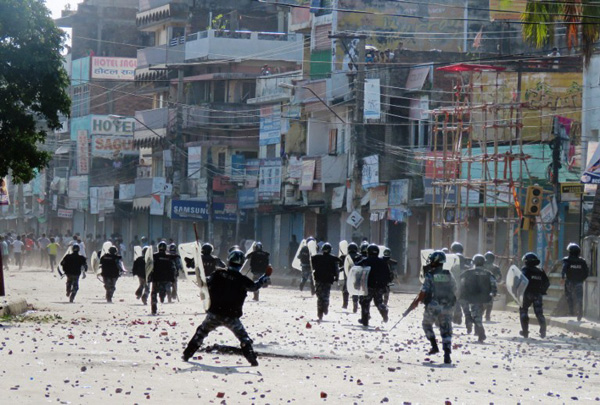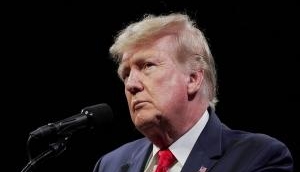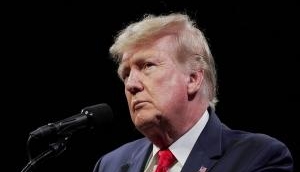Nepal must act to resolve the Madhesi crisis. And act fast

Theatre of trouble
- The Madhesi agitation is now almost three months old
- Recently an Indian citizen died when Nepal police opened fire at protestors
International players
- India doesn\'t have the influence it earlier had on Nepal
- China has used the opportunity to grow its clout with the Himalayan kingdom
More in the story
- Where the Nepalese establishment has gone wrong
- What is the way out
For nearly three months now, ethnic Madhesis in the southern plains of Nepal have been protesting against the new Constitution.
The Joint Madhesi Front (JMF) claims that provisions about citizenship, inclusion, participation, representation and federal demarcation in the recently adopted statute favour upper-caste Pahadis over Madhesis, Janjatis and other marginalized sections of the national population.
The ruling regime in Kathmandu has failed to respond to charges of manipulation and gerrymandering in a convincing manner. Instead it has suppressed the agitation with lethal force:
ALSO READ: The Madhesi blockade is almost total. How long can Nepal take it?
Prohibitory orders and curfews have been imposed at slightest pretext. Protestors have been caught and shot in brutal manner. Over 50 people, including nine policemen, lost their lives by the time JMF decided to sit in protests at the main entry points along the Indo-Nepal border.
Disturbances at entry points disrupted flow of goods into Nepal, but it also made the ruling regime realize that ruthless suppression was not an effective way of neutralizing protests.
Since the blockades began, no protestor was killed by the police for more than a month. But the situation changed earlier this week.
In an unexpected move, the Nepalese police charged upon protestors and cleared the Miteri Pool (Friendship Bridge) over Sirsiya River along the border near Birgunj. For over a month, agitators occupied this point, on the other side of which is Raxaul in Bihar.
ALSO READ: KP Sharma Oli: why Nepal's new PM isn't the right man for the job
People gathered from nearby villagers soon after and reoccupied the bridge. In the melee, the Nepalese police shot a young student through the head killing him instantly. The victim was an Indian student from Raxaul.
The police action in Birgunj-Raxaul sparked a flurry of diplomatic activities in the two Capitals. The Indian Embassy in Kathmandu raised concern over the firing and called upon the Government of Nepal to address causes of the confrontation "credibly and effectively".
The Nepalese ambassador in New Delhi clarified the situation to the Indian foreign ministry. Premier Khadga Prasad Sharma Oli spoke to his Indian counterpart over the telephone for half-an-hour.

Photo: AFP
Blame India
Meanwhile, Oli's party colleague and a Cabinet minister said in the industrial town of Biratnagar that since India couldn't send its Army in uniform, Indian soldiers could enter Nepal in plain clothes.
The wild allegation was in line with Kathmandu's propaganda that India was behind everything happening in Madhes. The Indian Embassy in Kathmandu has to issue a strongly worded statement against the aspersion.
It seems the official Indo-Nepal relationships have hit a new low. That could have been the reason the Indian media has been scrutinizing the failures of Prime Minister Narendra Modi's "neighbourhood first" foreign policy.
India doesn't have the same clout it once had with Nepal
Elephantine acrobatics
Ever since King Tribhuvan took shelter in the Indian Embassy in Kathmandu in the autumn of 1950 and sought its help to oust the absolutist Ranas from power, New Delhi has been cautiously balancing interests of the ruling elite and aspirations of opposition forces in a careful manner.
India was instrumental in restoring the primacy of the Shah Dynasty in Nepal, but had to soon wring its hands in frustration as King Mahendra began to woo the Chinese to counter the Indian influence in his kingdom.
In 1961, King Mahendra signed a deal with Beijing to build a road connecting Tibet with Kathmandu. When India protested about its strategic implications, the Hindu monarch retorted that communism didn't travel in automobiles.
ALSO READ: Nepal, India and Madhesis: all need a course correction
As it happened, communists of the Maoist variety were instrumental in doing away with the Shah Dynasty within half-a-century. Ideas have other ways of spreading, but logistics flow fast through a highway into a landlocked country.
Perhaps due to the compulsions of the Cold War, New Delhi considered the idea of Permanent Establishment of Nepal (PEON) for almost three decades afterward. In a course correction of foreign policy, India sided with democratic forces in 1989-90, prompting King Birendra to restore multi-party democracy.
When the Maoist insurgency began to cripple Nepal, India engineered a 12-point understanding between the rebels and the mainstream parties in November 2005. It was signed and sealed in New Delhi. That led to the election of the Constituent Assembly, the ouster of monarchy, declaration of a federal democratic republic and the restoration of normalcy in Nepal.
The exact role of India in forming the extra-constitutional government under the sitting Chief Justice of the Supreme Court to conduct fresh elections for the Constituent Assembly in March 2013 is unclear. But after that Indian started losing influence.
The Modi effect
Perhaps in a replication of Indian policies of the early-1970s, Indian Prime Minister Narendra Kumar Modi tried to woo the Permanent Establishment of Nepal with dramatic gestures. In August 2014, he became the first Indian PM to visit Kathmandu after a 17 years, trying to play to the gallery flaunting the family reunion of his Nepalese godson.
He backed his flowery words to the Nepalese Parliament with a concrete scheme of extending a billion-dollar credit line for development projects in Nepal. Despite some controversies over his cancelled excursions outside of Kathmandu, Modi made another history by revisiting Nepal in November 2014 for the Saarc Summit.
ALSO READ: Why Nepal's supply line remains choked
After the April earthquake, he earned accolades for being the first and the largest among rescue nations. The goodwill was soon lost as the Chinese began to pour in aid and exercise power in areas close to the Tibetan border.
Modi's strategy fell flat with the promulgation of the new Constitution and the formation of a coalition government of one-time Stalinist, former Maoists, erstwhile monarchists and self-declared nationalists of all hues.
They have only one thing in common: A shared contempt for Madhesis and a collective determination of reviving the Mahendra-era policy of enticing China to counter pervasive Indian influence in culture, economy, polity and society of Nepal.

Photo: AFP
Dragon Dance
The Chinese have consistently found that they don't have to do much to earn the confidence in Kathmandu. A grant-in-aid for a road here, a bridge there, and continuous reaffirmation of recognition of Nepal's territorial integrity, independence and sovereignty is enough to make hearts of patriotic Nepalese swell with pride.
Stability in the bordering regions of volatile Tibet is perhaps the primary concern of the Chinese. For them, keeping Nepal in good humour is a small price to pay for the huge leverage they maintain in return.
In a symbolic expression of goodwill, the Chinese agreed to supply 1,000 tonnes of petrol to Nepal. Twelve fuel tankers arrived in the capital via Kyirong border post through the circuitous earthen road that connects Rasuwagadhi with Kathmandu.
ALSO READ: Nepal Constitution: take everyone along, or prepare for crisis
There is a lot of excitement about relief from Beijing. Brouhaha notwithstanding, the meager supply of Chinese oil and promised delivery of cooking gas is unlikely to bring much respite to fuel-starved Nepal.
Goods-laden transporters from mainland China has to traverse long distances through rough terrain prone to snowfall, storms and landslides. Though technically possible, it's extremely difficult for China to be a practical overland trade partner of Nepal.
The Kyirong Pass up north may be closer to Kathmandu than Benares along the Ganges down south, but there is no comparison between the significance of these two places in the lifestyle of most Nepalese.
Silent music
It's getting late for the regime in Kathmandu to realize that solutions to political problems lie in the Tarai: The longer it takes the government to work out an amicable settlement with protestors in Madhesh, the more mired it will get into the power play of outside forces.
The Human Rights Watch has slammed the government. Amnesty International has suggested constitutional revisions.
ALSO READ: Explained: violence over Nepal's new Constitution
After Monday's event, it will be increasingly difficult for India to maintain distance from the brewing crisis along its strategically sensitive border.
The Permanent Establishment of Nepal better realise what is in its interest - to resolve contested issues of the controversial Constitution through internal consultation between all political forces.
More in Catch:
Nepal has become a Hindu State through the backdoor
Aboriginals, Muslims, a Sikh, and 50% women: Canada's new cabinet is awesome
What happened at the Saudi diplomat's house: shocking first-person account
Why I am returning my National Awards: Tapan Bose
Selfie-Esteem: this Stanford PhD built an algorithm to rate your selfies
First published: 6 November 2015, 10:52 IST





![BJP's Kapil Mishra recreates Shankar Mahadevan’s ‘Breathless’ song to highlight Delhi pollution [WATCH] BJP's Kapil Mishra recreates Shankar Mahadevan’s ‘Breathless’ song to highlight Delhi pollution [WATCH]](https://images.catchnews.com/upload/2022/11/03/kapil-mishra_240884_300x172.png)

![Anupam Kher shares pictures of his toned body on 67th birthday [MUST SEE] Anupam Kher shares pictures of his toned body on 67th birthday [MUST SEE]](https://images.catchnews.com/upload/2022/03/07/Anupam_kher_231145_300x172.jpg)






